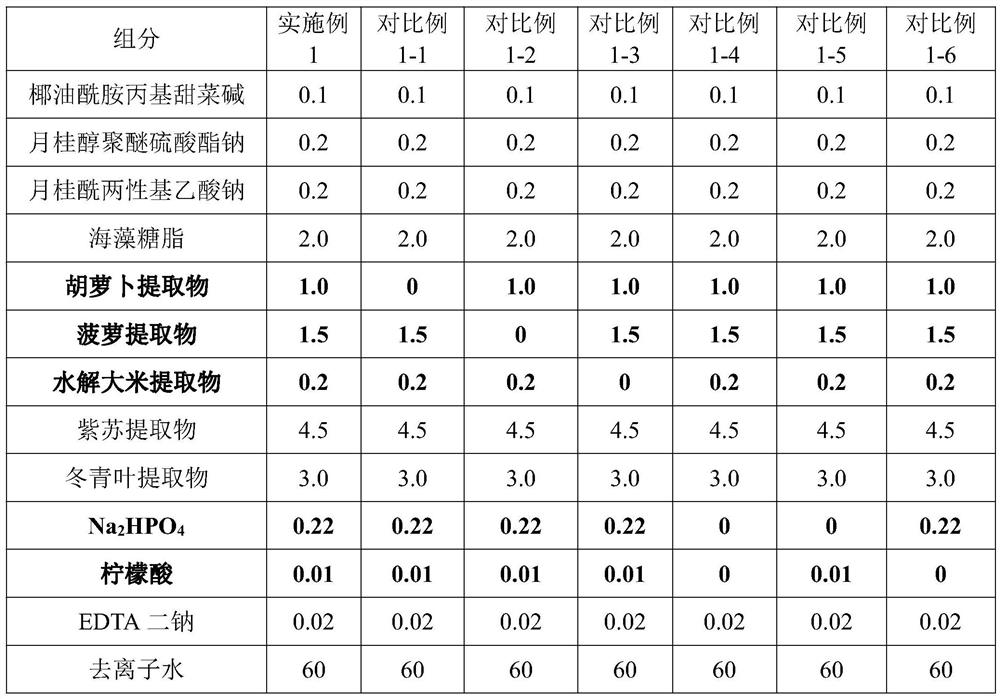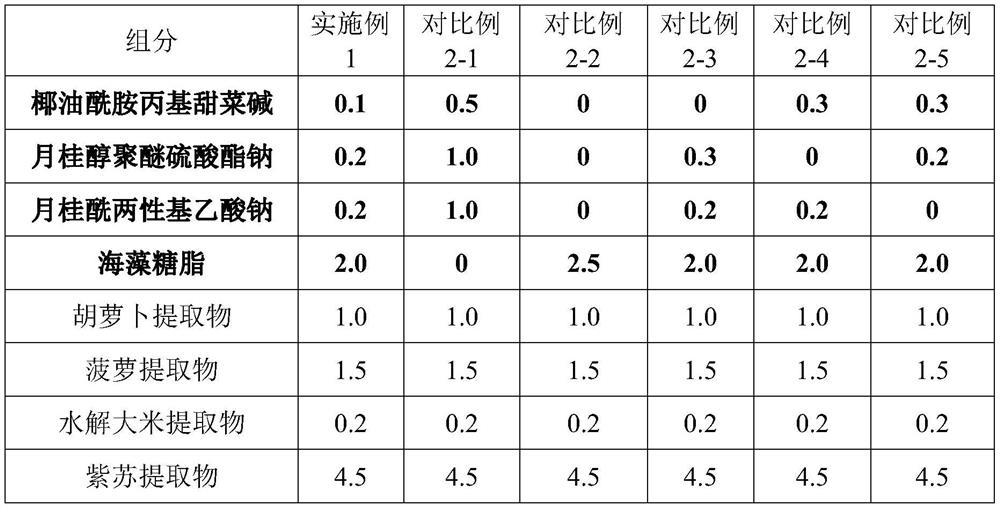A kind of milk bottle fruit and vegetable cleaner and preparation method thereof
A technology for cleaning agents, fruits and vegetables, applied in the field of cleaning agents, can solve the problems of low resistance of infants, insufficient cleaning, poor biodegradation performance, etc., and achieve the effects of strong adsorption selectivity, protection of health, and high biodegradation rate.
- Summary
- Abstract
- Description
- Claims
- Application Information
AI Technical Summary
Problems solved by technology
Method used
Image
Examples
Embodiment 1
[0029] A milk bottle fruit and vegetable cleaning agent, the cleaning agent comprises 0.1 part by weight of cocamidopropyl betaine, 0.2 part of sodium laureth sulfate, 0.2 part of sodium lauroamphoacetate, 2.0 part of trehalolipid , 1.0 parts carrot extract, 1.5 parts pineapple extract, 0.2 parts hydrolyzed rice extract, 4.5 parts perilla extract, 3.0 parts wintergreen leaf extract, 0.22 parts Na 2 HPO 4 , 0.01 parts citric acid, 0.02 parts disodium EDTA, and 60.0 parts deionized water.
[0030] The preparation method of above-mentioned cleaning agent comprises:
[0031] (1) Weigh 0.22 parts of Na by weight 2 HPO 4 , 0.01 part of citric acid is fully dissolved in 60.0 parts of deionized water to form solution A; then solution A is heated to 50-60 ° C, and 0.1 part of cocamidopropyl betaine, 0.2 part of sodium laureth sulfate, 0.2 parts of sodium lauroamphoacetate and 2.0 parts of trehalose lipid are stirred and mixed evenly to obtain mixture B;
[0032] (2) Cool the mixtu...
Embodiment 2
[0034] A milk bottle fruit and vegetable cleaning agent, the cleaning agent comprises 0.3 part by weight of cocamidopropyl betaine, 0.6 part of sodium laureth sulfate, 0.6 part of sodium lauroamphoacetate, 5.5 part of sophorolipid , 0.3 parts carrot extract, 0.5 parts pineapple extract, 1.0 parts hydrolyzed rice extract, 6.0 parts perilla extract, 4.5 parts wintergreen leaf extract, 0.35 parts Na2HPO4, 0.04 parts citric acid, 0.1 parts sodium chloride and 75.0 parts deionized water.
[0035] The preparation method is the same as in Example 1.
Embodiment 3
[0037]A milk bottle fruit and vegetable cleaning agent, the cleaning agent comprises 0.4 part by weight of cocamidopropyl betaine, 0.8 part of sodium laureth sulfate, 0.8 part of sodium lauroamphoacetate, and 1.0 part of trehalolipid , 2.0 parts sophorolipids, 0.6 parts carrot extract, 3.0 parts pineapple extract, 1.5 parts hydrolyzed rice extract, 3.2 parts perilla extract, 5.5 parts wintergreen leaf extract, 0.5 parts Na2HPO4, 0.08 parts citric acid, 0.25 parts parts disodium EDTA and 90.0 parts deionized water.
[0038] The preparation method of above-mentioned cleaning agent comprises:
[0039] (1) take by weighing 0.5 part of Na HPO , 0.08 part of citric acid are fully dissolved in 90.0 parts of deionized water to form solution A; Then solution A is heated to 50-60 ℃, and 0.4 part of cocamidopropyl betaine is added successively, 0.8 part of sodium laureth sulfate, 0.8 part of sodium lauroamphoacetate, 1.0 part of trehalolipid, and 2.0 part of sophorolipid were stirred an...
PUM
 Login to View More
Login to View More Abstract
Description
Claims
Application Information
 Login to View More
Login to View More - R&D
- Intellectual Property
- Life Sciences
- Materials
- Tech Scout
- Unparalleled Data Quality
- Higher Quality Content
- 60% Fewer Hallucinations
Browse by: Latest US Patents, China's latest patents, Technical Efficacy Thesaurus, Application Domain, Technology Topic, Popular Technical Reports.
© 2025 PatSnap. All rights reserved.Legal|Privacy policy|Modern Slavery Act Transparency Statement|Sitemap|About US| Contact US: help@patsnap.com



